Political Analysis of Different Empires: Insights into Persian and Babylonian Empires
VerifiedAdded on 2023/04/25
|9
|2122
|159
AI Summary
In this analysis we will discuss about detaileld analysis of different empires and below are the summaries point:-
The text provides a political analysis of different empires, specifically focusing on the Persian and Babylonian empires.
The Babylonian empire was characterized by small city states that eventually gave rise to powerful kingdoms. Prominent kings like Hammurabi and Nebuchadnezzar ruled the empire, and there were several revolts and revolutions.
The Akkadian empire, the first empire of Mesopotamia, had leaders such as Sargon of Akkad and Naram-Sin. Its government consisted of city-states.
Contribute Materials
Your contribution can guide someone’s learning journey. Share your
documents today.
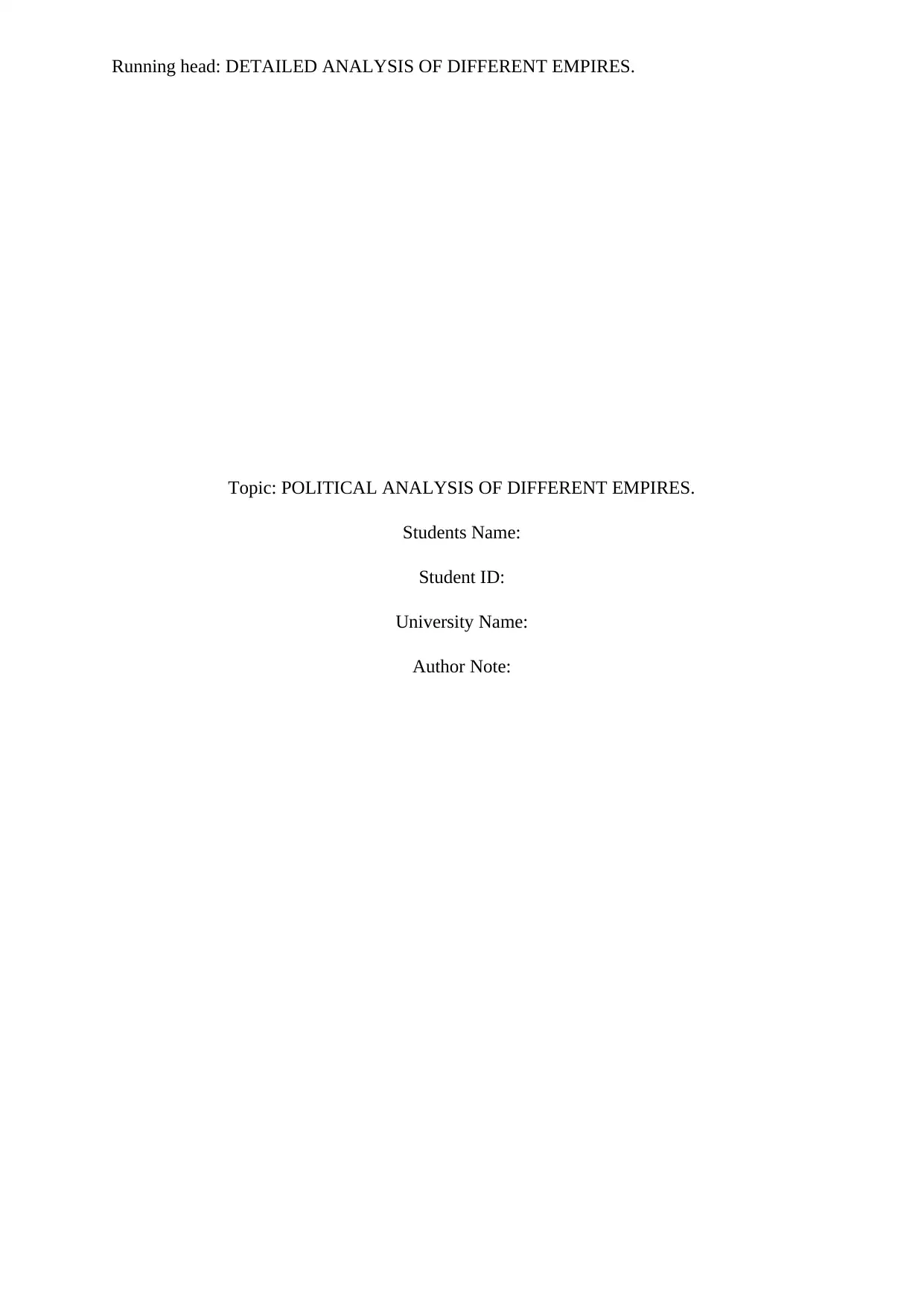
Running head: DETAILED ANALYSIS OF DIFFERENT EMPIRES.
Topic: POLITICAL ANALYSIS OF DIFFERENT EMPIRES.
Students Name:
Student ID:
University Name:
Author Note:
Topic: POLITICAL ANALYSIS OF DIFFERENT EMPIRES.
Students Name:
Student ID:
University Name:
Author Note:
Secure Best Marks with AI Grader
Need help grading? Try our AI Grader for instant feedback on your assignments.
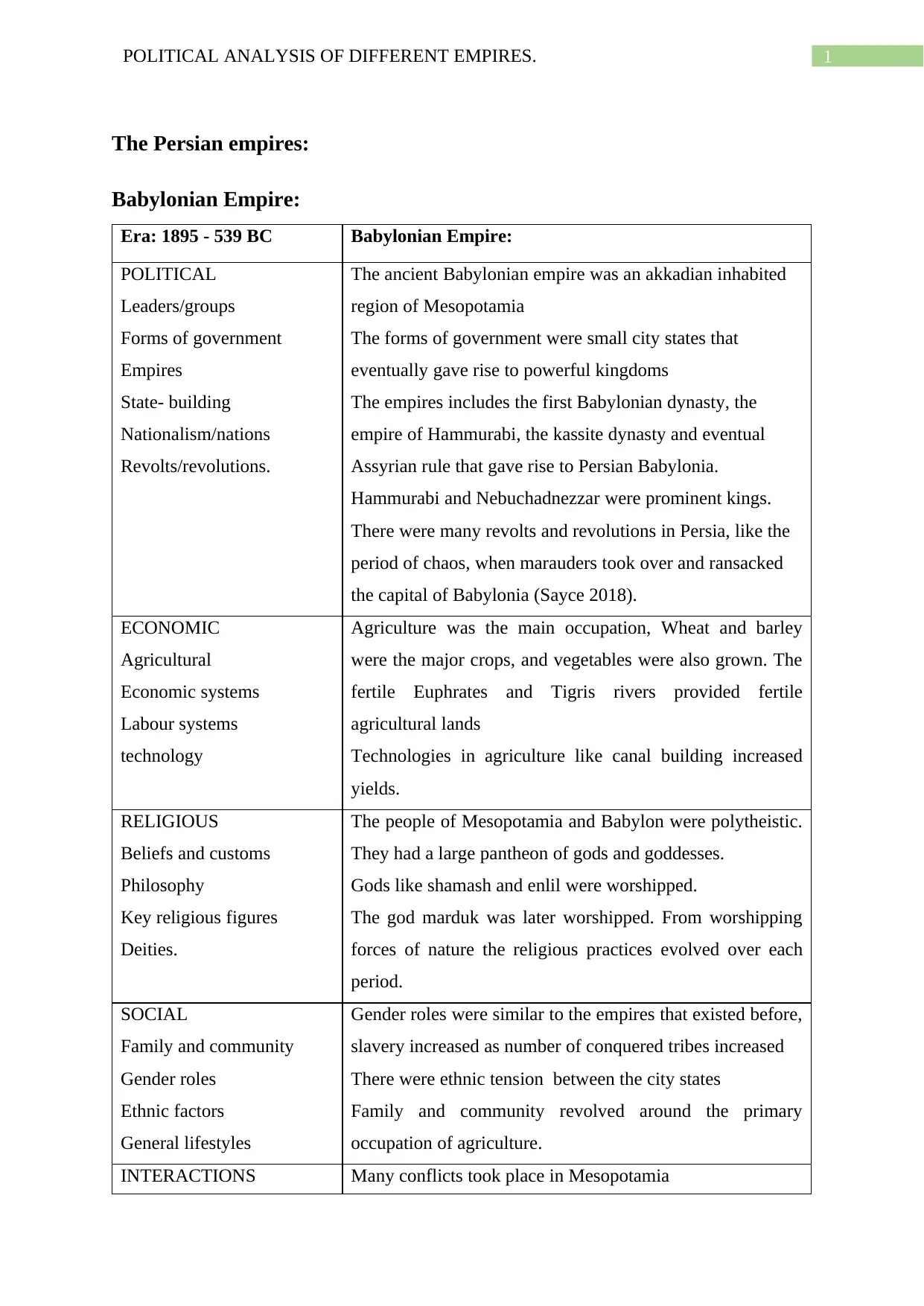
1POLITICAL ANALYSIS OF DIFFERENT EMPIRES.
The Persian empires:
Babylonian Empire:
Era: 1895 - 539 BC Babylonian Empire:
POLITICAL
Leaders/groups
Forms of government
Empires
State- building
Nationalism/nations
Revolts/revolutions.
The ancient Babylonian empire was an akkadian inhabited
region of Mesopotamia
The forms of government were small city states that
eventually gave rise to powerful kingdoms
The empires includes the first Babylonian dynasty, the
empire of Hammurabi, the kassite dynasty and eventual
Assyrian rule that gave rise to Persian Babylonia.
Hammurabi and Nebuchadnezzar were prominent kings.
There were many revolts and revolutions in Persia, like the
period of chaos, when marauders took over and ransacked
the capital of Babylonia (Sayce 2018).
ECONOMIC
Agricultural
Economic systems
Labour systems
technology
Agriculture was the main occupation, Wheat and barley
were the major crops, and vegetables were also grown. The
fertile Euphrates and Tigris rivers provided fertile
agricultural lands
Technologies in agriculture like canal building increased
yields.
RELIGIOUS
Beliefs and customs
Philosophy
Key religious figures
Deities.
The people of Mesopotamia and Babylon were polytheistic.
They had a large pantheon of gods and goddesses.
Gods like shamash and enlil were worshipped.
The god marduk was later worshipped. From worshipping
forces of nature the religious practices evolved over each
period.
SOCIAL
Family and community
Gender roles
Ethnic factors
General lifestyles
Gender roles were similar to the empires that existed before,
slavery increased as number of conquered tribes increased
There were ethnic tension between the city states
Family and community revolved around the primary
occupation of agriculture.
INTERACTIONS Many conflicts took place in Mesopotamia
The Persian empires:
Babylonian Empire:
Era: 1895 - 539 BC Babylonian Empire:
POLITICAL
Leaders/groups
Forms of government
Empires
State- building
Nationalism/nations
Revolts/revolutions.
The ancient Babylonian empire was an akkadian inhabited
region of Mesopotamia
The forms of government were small city states that
eventually gave rise to powerful kingdoms
The empires includes the first Babylonian dynasty, the
empire of Hammurabi, the kassite dynasty and eventual
Assyrian rule that gave rise to Persian Babylonia.
Hammurabi and Nebuchadnezzar were prominent kings.
There were many revolts and revolutions in Persia, like the
period of chaos, when marauders took over and ransacked
the capital of Babylonia (Sayce 2018).
ECONOMIC
Agricultural
Economic systems
Labour systems
technology
Agriculture was the main occupation, Wheat and barley
were the major crops, and vegetables were also grown. The
fertile Euphrates and Tigris rivers provided fertile
agricultural lands
Technologies in agriculture like canal building increased
yields.
RELIGIOUS
Beliefs and customs
Philosophy
Key religious figures
Deities.
The people of Mesopotamia and Babylon were polytheistic.
They had a large pantheon of gods and goddesses.
Gods like shamash and enlil were worshipped.
The god marduk was later worshipped. From worshipping
forces of nature the religious practices evolved over each
period.
SOCIAL
Family and community
Gender roles
Ethnic factors
General lifestyles
Gender roles were similar to the empires that existed before,
slavery increased as number of conquered tribes increased
There were ethnic tension between the city states
Family and community revolved around the primary
occupation of agriculture.
INTERACTIONS Many conflicts took place in Mesopotamia
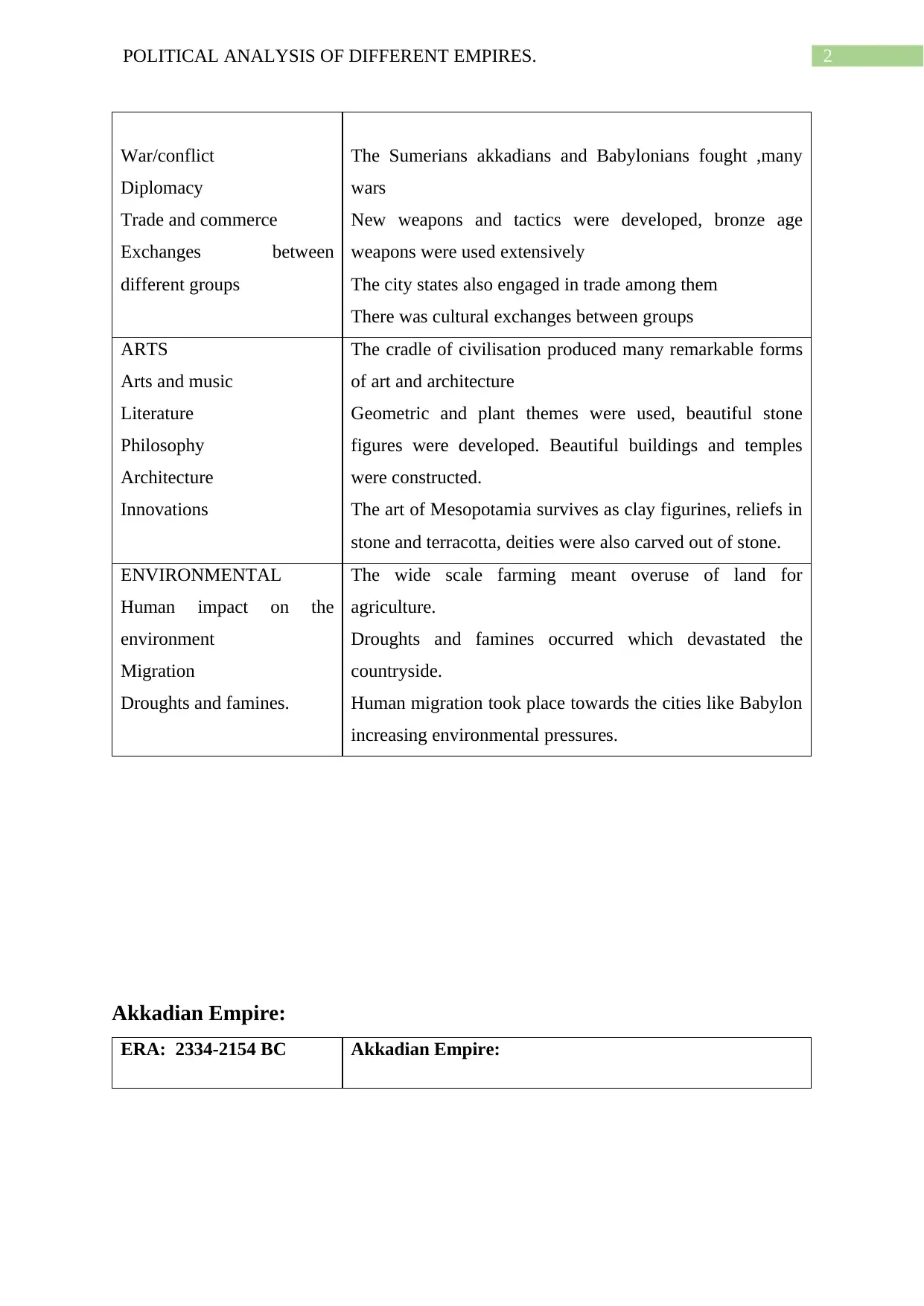
2POLITICAL ANALYSIS OF DIFFERENT EMPIRES.
War/conflict
Diplomacy
Trade and commerce
Exchanges between
different groups
The Sumerians akkadians and Babylonians fought ,many
wars
New weapons and tactics were developed, bronze age
weapons were used extensively
The city states also engaged in trade among them
There was cultural exchanges between groups
ARTS
Arts and music
Literature
Philosophy
Architecture
Innovations
The cradle of civilisation produced many remarkable forms
of art and architecture
Geometric and plant themes were used, beautiful stone
figures were developed. Beautiful buildings and temples
were constructed.
The art of Mesopotamia survives as clay figurines, reliefs in
stone and terracotta, deities were also carved out of stone.
ENVIRONMENTAL
Human impact on the
environment
Migration
Droughts and famines.
The wide scale farming meant overuse of land for
agriculture.
Droughts and famines occurred which devastated the
countryside.
Human migration took place towards the cities like Babylon
increasing environmental pressures.
Akkadian Empire:
ERA: 2334-2154 BC Akkadian Empire:
War/conflict
Diplomacy
Trade and commerce
Exchanges between
different groups
The Sumerians akkadians and Babylonians fought ,many
wars
New weapons and tactics were developed, bronze age
weapons were used extensively
The city states also engaged in trade among them
There was cultural exchanges between groups
ARTS
Arts and music
Literature
Philosophy
Architecture
Innovations
The cradle of civilisation produced many remarkable forms
of art and architecture
Geometric and plant themes were used, beautiful stone
figures were developed. Beautiful buildings and temples
were constructed.
The art of Mesopotamia survives as clay figurines, reliefs in
stone and terracotta, deities were also carved out of stone.
ENVIRONMENTAL
Human impact on the
environment
Migration
Droughts and famines.
The wide scale farming meant overuse of land for
agriculture.
Droughts and famines occurred which devastated the
countryside.
Human migration took place towards the cities like Babylon
increasing environmental pressures.
Akkadian Empire:
ERA: 2334-2154 BC Akkadian Empire:
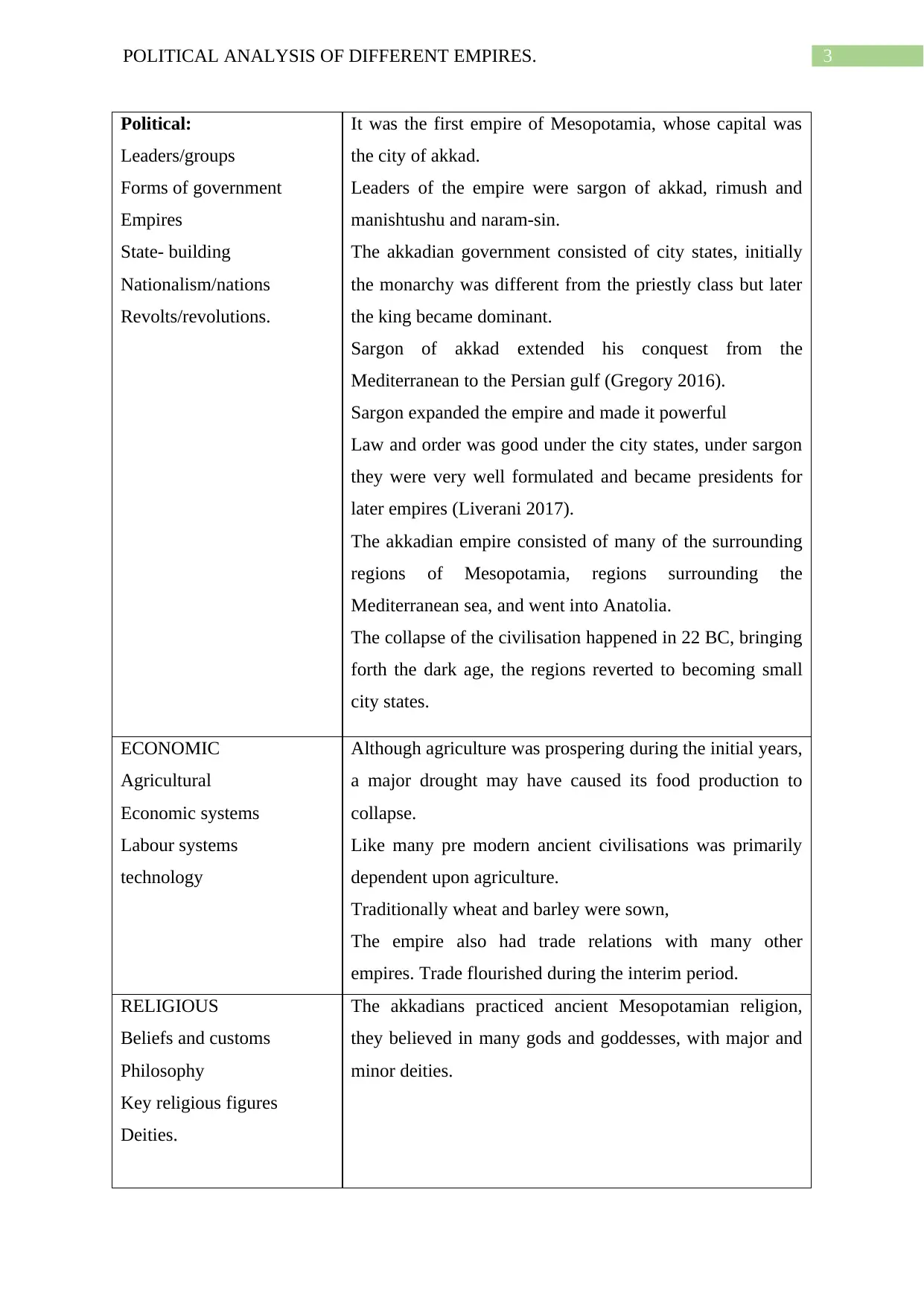
3POLITICAL ANALYSIS OF DIFFERENT EMPIRES.
Political:
Leaders/groups
Forms of government
Empires
State- building
Nationalism/nations
Revolts/revolutions.
It was the first empire of Mesopotamia, whose capital was
the city of akkad.
Leaders of the empire were sargon of akkad, rimush and
manishtushu and naram-sin.
The akkadian government consisted of city states, initially
the monarchy was different from the priestly class but later
the king became dominant.
Sargon of akkad extended his conquest from the
Mediterranean to the Persian gulf (Gregory 2016).
Sargon expanded the empire and made it powerful
Law and order was good under the city states, under sargon
they were very well formulated and became presidents for
later empires (Liverani 2017).
The akkadian empire consisted of many of the surrounding
regions of Mesopotamia, regions surrounding the
Mediterranean sea, and went into Anatolia.
The collapse of the civilisation happened in 22 BC, bringing
forth the dark age, the regions reverted to becoming small
city states.
ECONOMIC
Agricultural
Economic systems
Labour systems
technology
Although agriculture was prospering during the initial years,
a major drought may have caused its food production to
collapse.
Like many pre modern ancient civilisations was primarily
dependent upon agriculture.
Traditionally wheat and barley were sown,
The empire also had trade relations with many other
empires. Trade flourished during the interim period.
RELIGIOUS
Beliefs and customs
Philosophy
Key religious figures
Deities.
The akkadians practiced ancient Mesopotamian religion,
they believed in many gods and goddesses, with major and
minor deities.
Political:
Leaders/groups
Forms of government
Empires
State- building
Nationalism/nations
Revolts/revolutions.
It was the first empire of Mesopotamia, whose capital was
the city of akkad.
Leaders of the empire were sargon of akkad, rimush and
manishtushu and naram-sin.
The akkadian government consisted of city states, initially
the monarchy was different from the priestly class but later
the king became dominant.
Sargon of akkad extended his conquest from the
Mediterranean to the Persian gulf (Gregory 2016).
Sargon expanded the empire and made it powerful
Law and order was good under the city states, under sargon
they were very well formulated and became presidents for
later empires (Liverani 2017).
The akkadian empire consisted of many of the surrounding
regions of Mesopotamia, regions surrounding the
Mediterranean sea, and went into Anatolia.
The collapse of the civilisation happened in 22 BC, bringing
forth the dark age, the regions reverted to becoming small
city states.
ECONOMIC
Agricultural
Economic systems
Labour systems
technology
Although agriculture was prospering during the initial years,
a major drought may have caused its food production to
collapse.
Like many pre modern ancient civilisations was primarily
dependent upon agriculture.
Traditionally wheat and barley were sown,
The empire also had trade relations with many other
empires. Trade flourished during the interim period.
RELIGIOUS
Beliefs and customs
Philosophy
Key religious figures
Deities.
The akkadians practiced ancient Mesopotamian religion,
they believed in many gods and goddesses, with major and
minor deities.
Secure Best Marks with AI Grader
Need help grading? Try our AI Grader for instant feedback on your assignments.
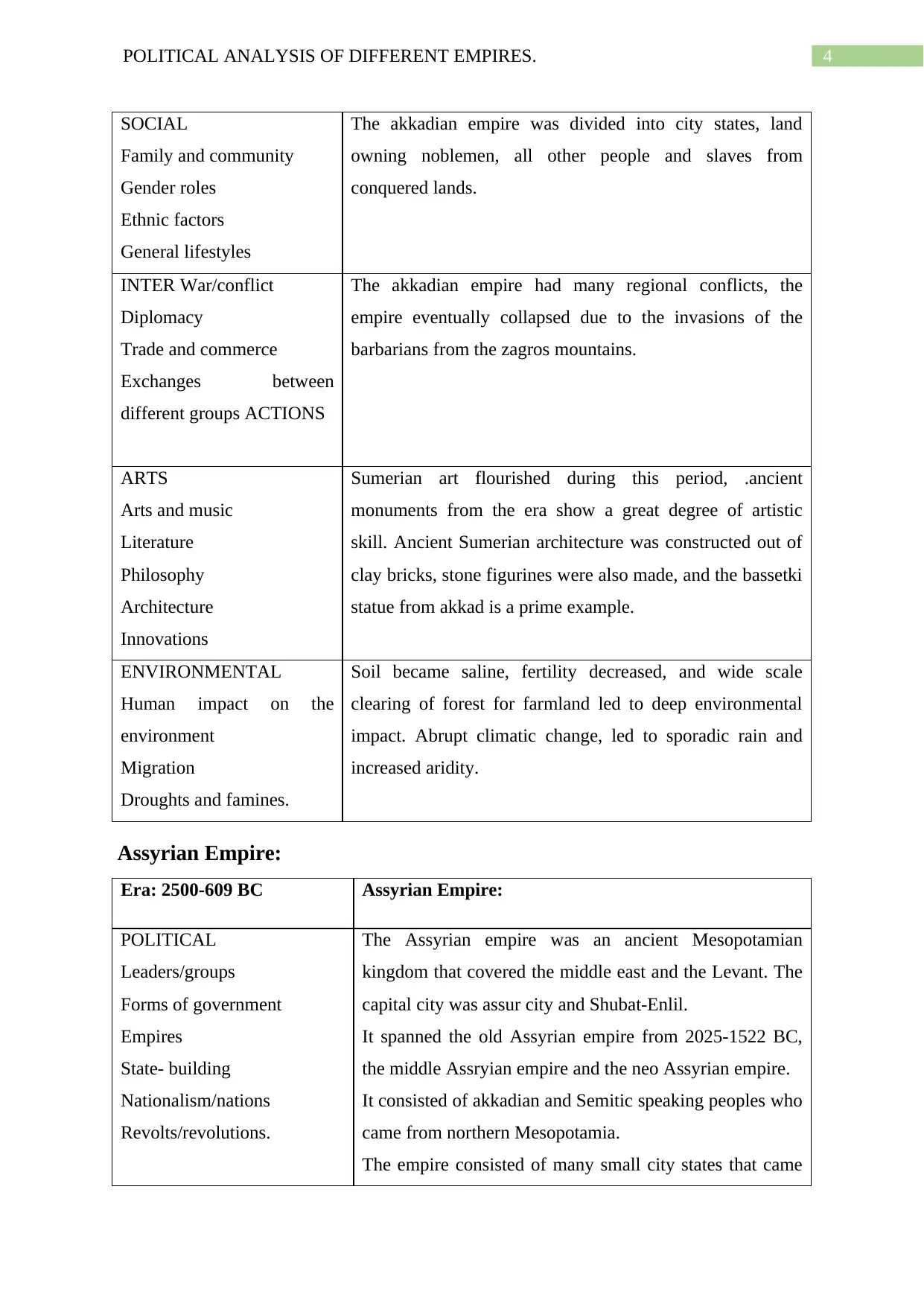
4POLITICAL ANALYSIS OF DIFFERENT EMPIRES.
SOCIAL
Family and community
Gender roles
Ethnic factors
General lifestyles
The akkadian empire was divided into city states, land
owning noblemen, all other people and slaves from
conquered lands.
INTER War/conflict
Diplomacy
Trade and commerce
Exchanges between
different groups ACTIONS
The akkadian empire had many regional conflicts, the
empire eventually collapsed due to the invasions of the
barbarians from the zagros mountains.
ARTS
Arts and music
Literature
Philosophy
Architecture
Innovations
Sumerian art flourished during this period, .ancient
monuments from the era show a great degree of artistic
skill. Ancient Sumerian architecture was constructed out of
clay bricks, stone figurines were also made, and the bassetki
statue from akkad is a prime example.
ENVIRONMENTAL
Human impact on the
environment
Migration
Droughts and famines.
Soil became saline, fertility decreased, and wide scale
clearing of forest for farmland led to deep environmental
impact. Abrupt climatic change, led to sporadic rain and
increased aridity.
Assyrian Empire:
Era: 2500-609 BC Assyrian Empire:
POLITICAL
Leaders/groups
Forms of government
Empires
State- building
Nationalism/nations
Revolts/revolutions.
The Assyrian empire was an ancient Mesopotamian
kingdom that covered the middle east and the Levant. The
capital city was assur city and Shubat-Enlil.
It spanned the old Assyrian empire from 2025-1522 BC,
the middle Assryian empire and the neo Assyrian empire.
It consisted of akkadian and Semitic speaking peoples who
came from northern Mesopotamia.
The empire consisted of many small city states that came
SOCIAL
Family and community
Gender roles
Ethnic factors
General lifestyles
The akkadian empire was divided into city states, land
owning noblemen, all other people and slaves from
conquered lands.
INTER War/conflict
Diplomacy
Trade and commerce
Exchanges between
different groups ACTIONS
The akkadian empire had many regional conflicts, the
empire eventually collapsed due to the invasions of the
barbarians from the zagros mountains.
ARTS
Arts and music
Literature
Philosophy
Architecture
Innovations
Sumerian art flourished during this period, .ancient
monuments from the era show a great degree of artistic
skill. Ancient Sumerian architecture was constructed out of
clay bricks, stone figurines were also made, and the bassetki
statue from akkad is a prime example.
ENVIRONMENTAL
Human impact on the
environment
Migration
Droughts and famines.
Soil became saline, fertility decreased, and wide scale
clearing of forest for farmland led to deep environmental
impact. Abrupt climatic change, led to sporadic rain and
increased aridity.
Assyrian Empire:
Era: 2500-609 BC Assyrian Empire:
POLITICAL
Leaders/groups
Forms of government
Empires
State- building
Nationalism/nations
Revolts/revolutions.
The Assyrian empire was an ancient Mesopotamian
kingdom that covered the middle east and the Levant. The
capital city was assur city and Shubat-Enlil.
It spanned the old Assyrian empire from 2025-1522 BC,
the middle Assryian empire and the neo Assyrian empire.
It consisted of akkadian and Semitic speaking peoples who
came from northern Mesopotamia.
The empire consisted of many small city states that came
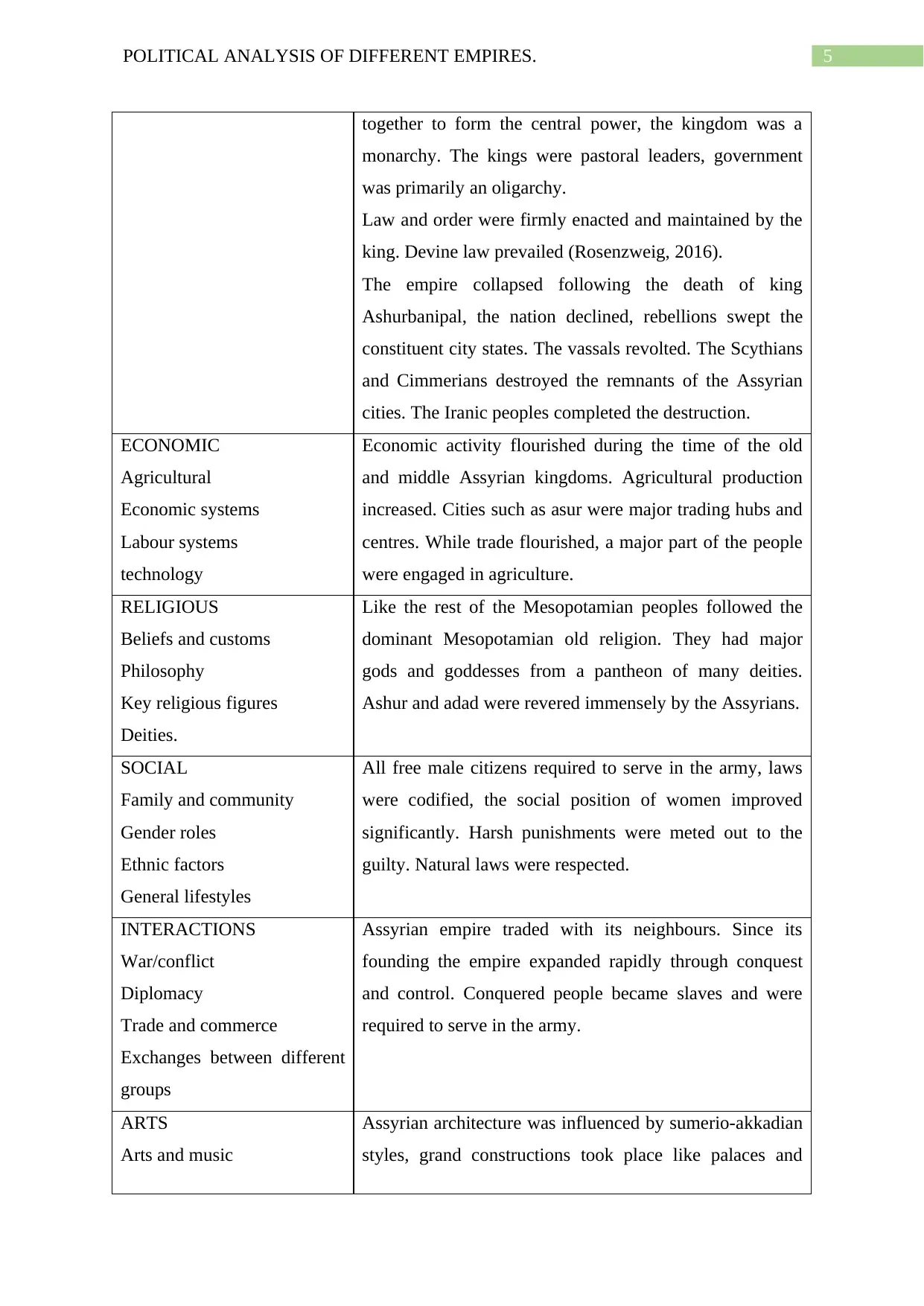
5POLITICAL ANALYSIS OF DIFFERENT EMPIRES.
together to form the central power, the kingdom was a
monarchy. The kings were pastoral leaders, government
was primarily an oligarchy.
Law and order were firmly enacted and maintained by the
king. Devine law prevailed (Rosenzweig, 2016).
The empire collapsed following the death of king
Ashurbanipal, the nation declined, rebellions swept the
constituent city states. The vassals revolted. The Scythians
and Cimmerians destroyed the remnants of the Assyrian
cities. The Iranic peoples completed the destruction.
ECONOMIC
Agricultural
Economic systems
Labour systems
technology
Economic activity flourished during the time of the old
and middle Assyrian kingdoms. Agricultural production
increased. Cities such as asur were major trading hubs and
centres. While trade flourished, a major part of the people
were engaged in agriculture.
RELIGIOUS
Beliefs and customs
Philosophy
Key religious figures
Deities.
Like the rest of the Mesopotamian peoples followed the
dominant Mesopotamian old religion. They had major
gods and goddesses from a pantheon of many deities.
Ashur and adad were revered immensely by the Assyrians.
SOCIAL
Family and community
Gender roles
Ethnic factors
General lifestyles
All free male citizens required to serve in the army, laws
were codified, the social position of women improved
significantly. Harsh punishments were meted out to the
guilty. Natural laws were respected.
INTERACTIONS
War/conflict
Diplomacy
Trade and commerce
Exchanges between different
groups
Assyrian empire traded with its neighbours. Since its
founding the empire expanded rapidly through conquest
and control. Conquered people became slaves and were
required to serve in the army.
ARTS
Arts and music
Assyrian architecture was influenced by sumerio-akkadian
styles, grand constructions took place like palaces and
together to form the central power, the kingdom was a
monarchy. The kings were pastoral leaders, government
was primarily an oligarchy.
Law and order were firmly enacted and maintained by the
king. Devine law prevailed (Rosenzweig, 2016).
The empire collapsed following the death of king
Ashurbanipal, the nation declined, rebellions swept the
constituent city states. The vassals revolted. The Scythians
and Cimmerians destroyed the remnants of the Assyrian
cities. The Iranic peoples completed the destruction.
ECONOMIC
Agricultural
Economic systems
Labour systems
technology
Economic activity flourished during the time of the old
and middle Assyrian kingdoms. Agricultural production
increased. Cities such as asur were major trading hubs and
centres. While trade flourished, a major part of the people
were engaged in agriculture.
RELIGIOUS
Beliefs and customs
Philosophy
Key religious figures
Deities.
Like the rest of the Mesopotamian peoples followed the
dominant Mesopotamian old religion. They had major
gods and goddesses from a pantheon of many deities.
Ashur and adad were revered immensely by the Assyrians.
SOCIAL
Family and community
Gender roles
Ethnic factors
General lifestyles
All free male citizens required to serve in the army, laws
were codified, the social position of women improved
significantly. Harsh punishments were meted out to the
guilty. Natural laws were respected.
INTERACTIONS
War/conflict
Diplomacy
Trade and commerce
Exchanges between different
groups
Assyrian empire traded with its neighbours. Since its
founding the empire expanded rapidly through conquest
and control. Conquered people became slaves and were
required to serve in the army.
ARTS
Arts and music
Assyrian architecture was influenced by sumerio-akkadian
styles, grand constructions took place like palaces and
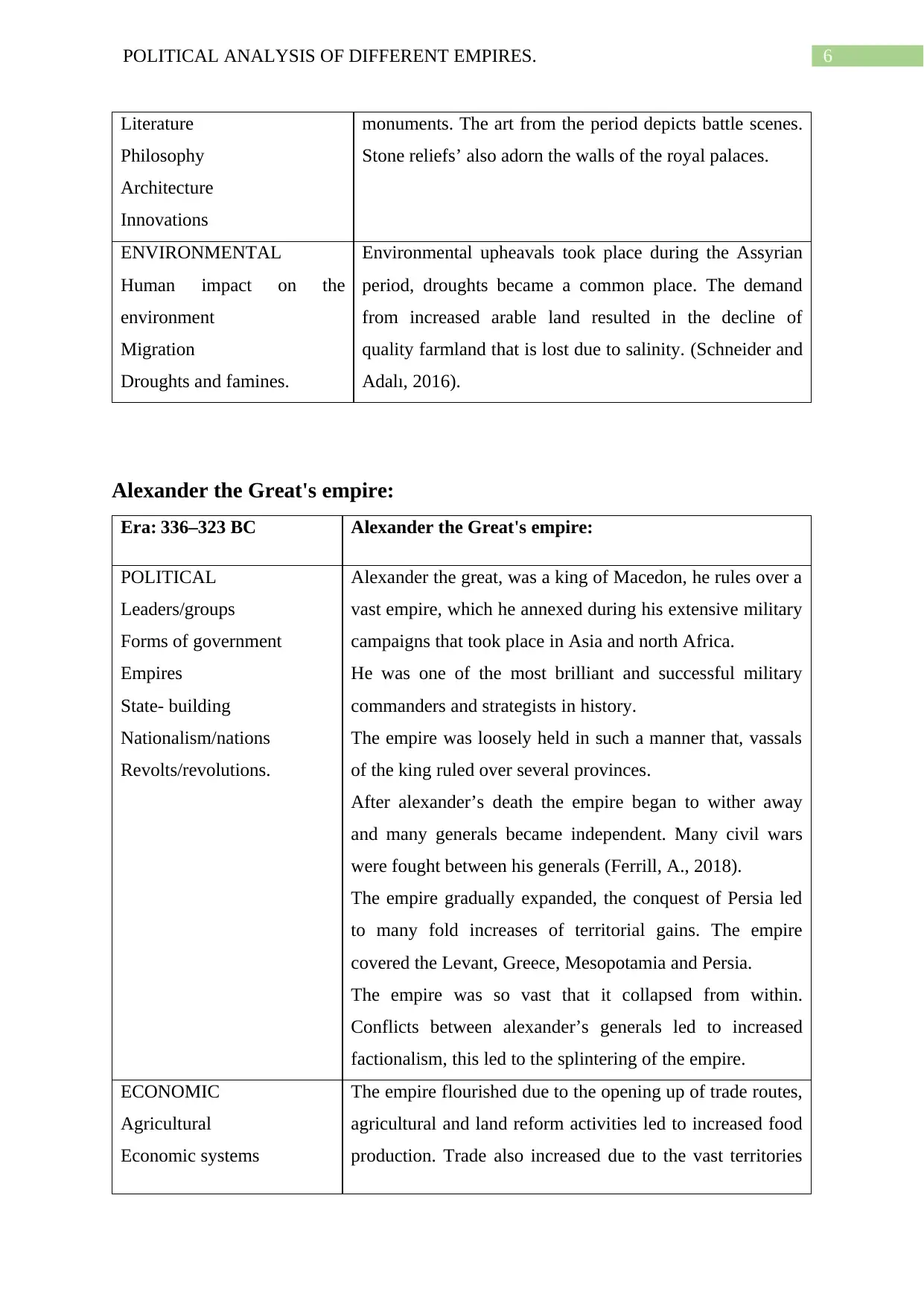
6POLITICAL ANALYSIS OF DIFFERENT EMPIRES.
Literature
Philosophy
Architecture
Innovations
monuments. The art from the period depicts battle scenes.
Stone reliefs’ also adorn the walls of the royal palaces.
ENVIRONMENTAL
Human impact on the
environment
Migration
Droughts and famines.
Environmental upheavals took place during the Assyrian
period, droughts became a common place. The demand
from increased arable land resulted in the decline of
quality farmland that is lost due to salinity. (Schneider and
Adalı, 2016).
Alexander the Great's empire:
Era: 336–323 BC Alexander the Great's empire:
POLITICAL
Leaders/groups
Forms of government
Empires
State- building
Nationalism/nations
Revolts/revolutions.
Alexander the great, was a king of Macedon, he rules over a
vast empire, which he annexed during his extensive military
campaigns that took place in Asia and north Africa.
He was one of the most brilliant and successful military
commanders and strategists in history.
The empire was loosely held in such a manner that, vassals
of the king ruled over several provinces.
After alexander’s death the empire began to wither away
and many generals became independent. Many civil wars
were fought between his generals (Ferrill, A., 2018).
The empire gradually expanded, the conquest of Persia led
to many fold increases of territorial gains. The empire
covered the Levant, Greece, Mesopotamia and Persia.
The empire was so vast that it collapsed from within.
Conflicts between alexander’s generals led to increased
factionalism, this led to the splintering of the empire.
ECONOMIC
Agricultural
Economic systems
The empire flourished due to the opening up of trade routes,
agricultural and land reform activities led to increased food
production. Trade also increased due to the vast territories
Literature
Philosophy
Architecture
Innovations
monuments. The art from the period depicts battle scenes.
Stone reliefs’ also adorn the walls of the royal palaces.
ENVIRONMENTAL
Human impact on the
environment
Migration
Droughts and famines.
Environmental upheavals took place during the Assyrian
period, droughts became a common place. The demand
from increased arable land resulted in the decline of
quality farmland that is lost due to salinity. (Schneider and
Adalı, 2016).
Alexander the Great's empire:
Era: 336–323 BC Alexander the Great's empire:
POLITICAL
Leaders/groups
Forms of government
Empires
State- building
Nationalism/nations
Revolts/revolutions.
Alexander the great, was a king of Macedon, he rules over a
vast empire, which he annexed during his extensive military
campaigns that took place in Asia and north Africa.
He was one of the most brilliant and successful military
commanders and strategists in history.
The empire was loosely held in such a manner that, vassals
of the king ruled over several provinces.
After alexander’s death the empire began to wither away
and many generals became independent. Many civil wars
were fought between his generals (Ferrill, A., 2018).
The empire gradually expanded, the conquest of Persia led
to many fold increases of territorial gains. The empire
covered the Levant, Greece, Mesopotamia and Persia.
The empire was so vast that it collapsed from within.
Conflicts between alexander’s generals led to increased
factionalism, this led to the splintering of the empire.
ECONOMIC
Agricultural
Economic systems
The empire flourished due to the opening up of trade routes,
agricultural and land reform activities led to increased food
production. Trade also increased due to the vast territories
Paraphrase This Document
Need a fresh take? Get an instant paraphrase of this document with our AI Paraphraser
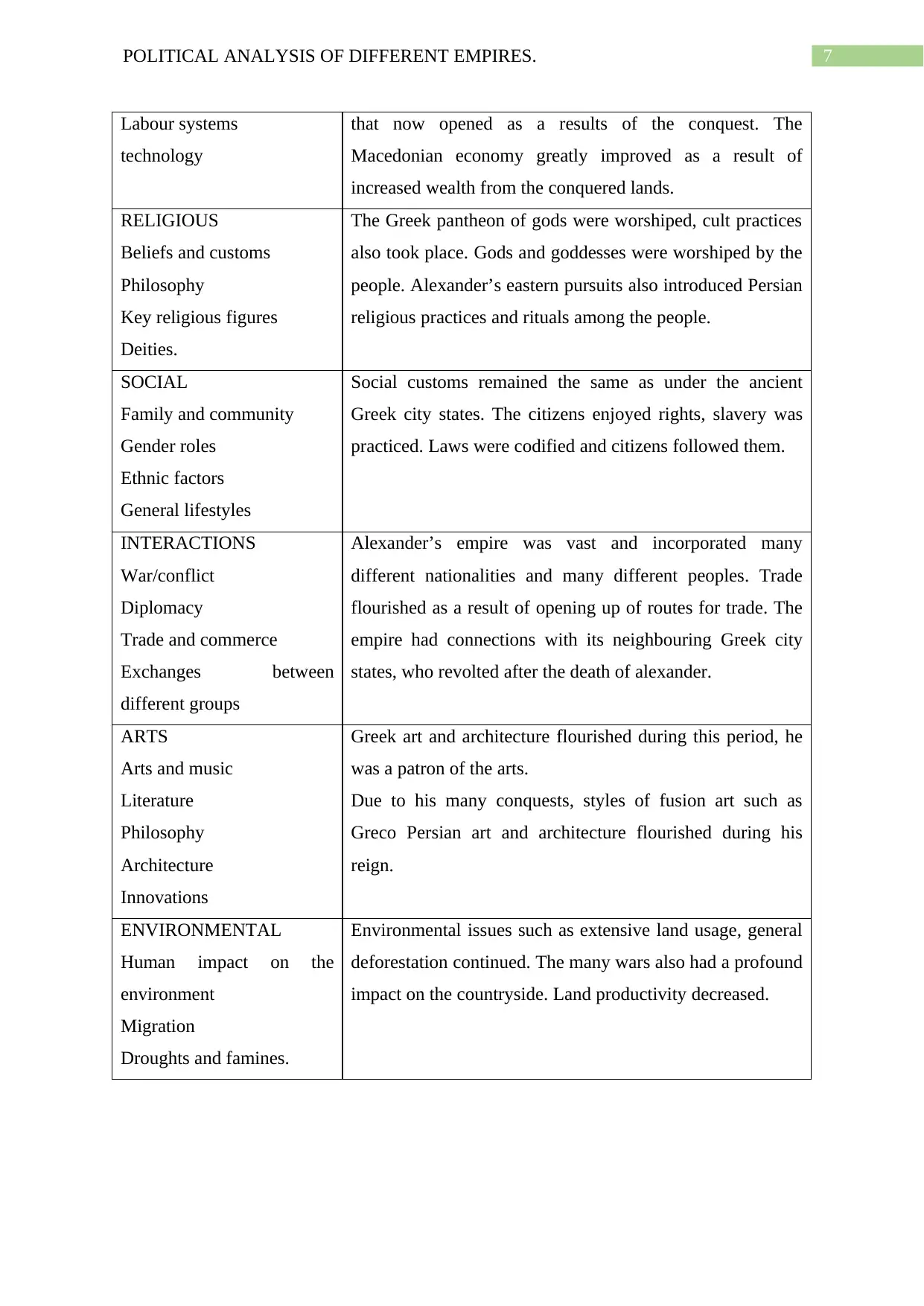
7POLITICAL ANALYSIS OF DIFFERENT EMPIRES.
Labour systems
technology
that now opened as a results of the conquest. The
Macedonian economy greatly improved as a result of
increased wealth from the conquered lands.
RELIGIOUS
Beliefs and customs
Philosophy
Key religious figures
Deities.
The Greek pantheon of gods were worshiped, cult practices
also took place. Gods and goddesses were worshiped by the
people. Alexander’s eastern pursuits also introduced Persian
religious practices and rituals among the people.
SOCIAL
Family and community
Gender roles
Ethnic factors
General lifestyles
Social customs remained the same as under the ancient
Greek city states. The citizens enjoyed rights, slavery was
practiced. Laws were codified and citizens followed them.
INTERACTIONS
War/conflict
Diplomacy
Trade and commerce
Exchanges between
different groups
Alexander’s empire was vast and incorporated many
different nationalities and many different peoples. Trade
flourished as a result of opening up of routes for trade. The
empire had connections with its neighbouring Greek city
states, who revolted after the death of alexander.
ARTS
Arts and music
Literature
Philosophy
Architecture
Innovations
Greek art and architecture flourished during this period, he
was a patron of the arts.
Due to his many conquests, styles of fusion art such as
Greco Persian art and architecture flourished during his
reign.
ENVIRONMENTAL
Human impact on the
environment
Migration
Droughts and famines.
Environmental issues such as extensive land usage, general
deforestation continued. The many wars also had a profound
impact on the countryside. Land productivity decreased.
Labour systems
technology
that now opened as a results of the conquest. The
Macedonian economy greatly improved as a result of
increased wealth from the conquered lands.
RELIGIOUS
Beliefs and customs
Philosophy
Key religious figures
Deities.
The Greek pantheon of gods were worshiped, cult practices
also took place. Gods and goddesses were worshiped by the
people. Alexander’s eastern pursuits also introduced Persian
religious practices and rituals among the people.
SOCIAL
Family and community
Gender roles
Ethnic factors
General lifestyles
Social customs remained the same as under the ancient
Greek city states. The citizens enjoyed rights, slavery was
practiced. Laws were codified and citizens followed them.
INTERACTIONS
War/conflict
Diplomacy
Trade and commerce
Exchanges between
different groups
Alexander’s empire was vast and incorporated many
different nationalities and many different peoples. Trade
flourished as a result of opening up of routes for trade. The
empire had connections with its neighbouring Greek city
states, who revolted after the death of alexander.
ARTS
Arts and music
Literature
Philosophy
Architecture
Innovations
Greek art and architecture flourished during this period, he
was a patron of the arts.
Due to his many conquests, styles of fusion art such as
Greco Persian art and architecture flourished during his
reign.
ENVIRONMENTAL
Human impact on the
environment
Migration
Droughts and famines.
Environmental issues such as extensive land usage, general
deforestation continued. The many wars also had a profound
impact on the countryside. Land productivity decreased.
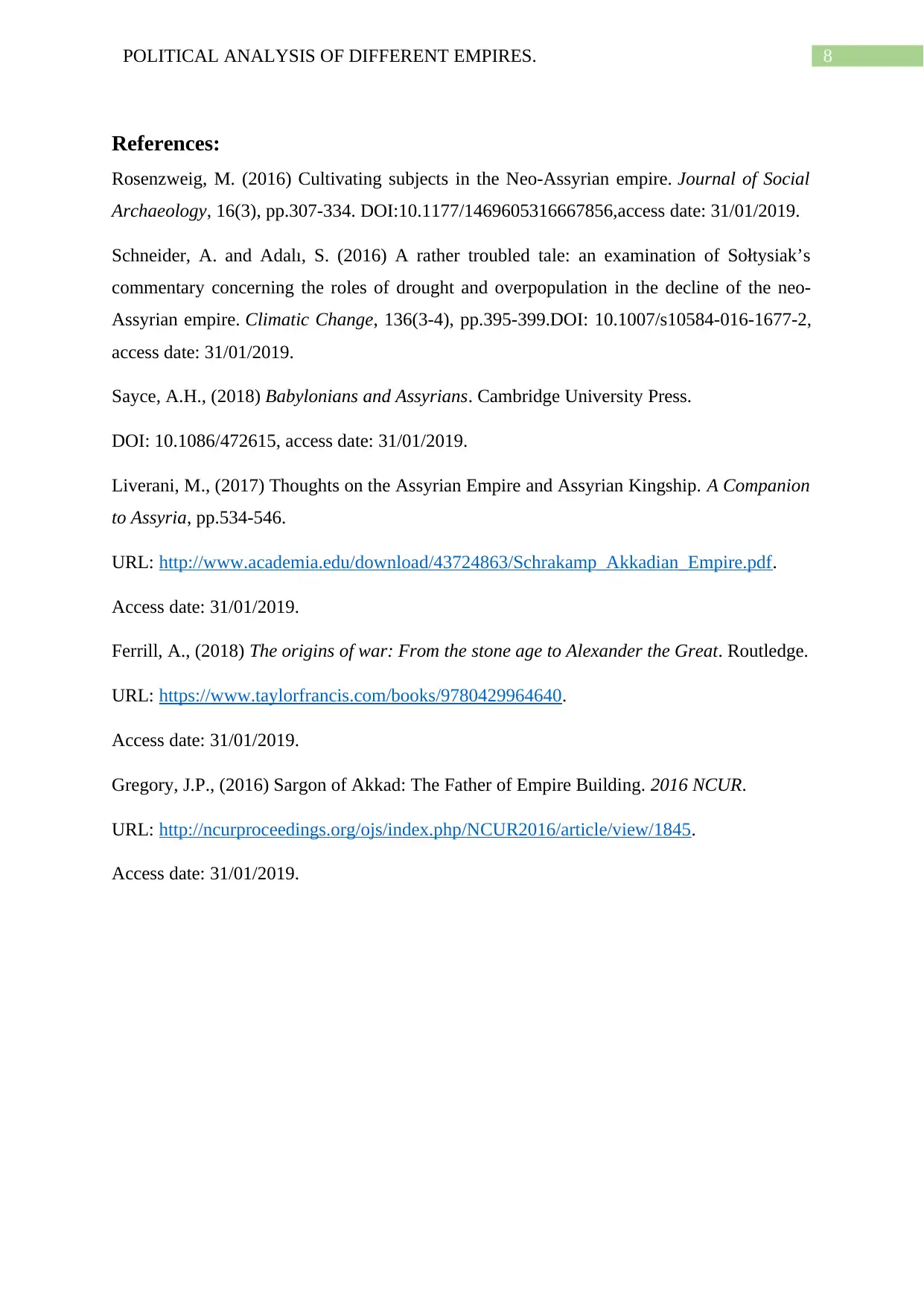
8POLITICAL ANALYSIS OF DIFFERENT EMPIRES.
References:
Rosenzweig, M. (2016) Cultivating subjects in the Neo-Assyrian empire. Journal of Social
Archaeology, 16(3), pp.307-334. DOI:10.1177/1469605316667856,access date: 31/01/2019.
Schneider, A. and Adalı, S. (2016) A rather troubled tale: an examination of Sołtysiak’s
commentary concerning the roles of drought and overpopulation in the decline of the neo-
Assyrian empire. Climatic Change, 136(3-4), pp.395-399.DOI: 10.1007/s10584-016-1677-2,
access date: 31/01/2019.
Sayce, A.H., (2018) Babylonians and Assyrians. Cambridge University Press.
DOI: 10.1086/472615, access date: 31/01/2019.
Liverani, M., (2017) Thoughts on the Assyrian Empire and Assyrian Kingship. A Companion
to Assyria, pp.534-546.
URL: http://www.academia.edu/download/43724863/Schrakamp_Akkadian_Empire.pdf.
Access date: 31/01/2019.
Ferrill, A., (2018) The origins of war: From the stone age to Alexander the Great. Routledge.
URL: https://www.taylorfrancis.com/books/9780429964640.
Access date: 31/01/2019.
Gregory, J.P., (2016) Sargon of Akkad: The Father of Empire Building. 2016 NCUR.
URL: http://ncurproceedings.org/ojs/index.php/NCUR2016/article/view/1845.
Access date: 31/01/2019.
References:
Rosenzweig, M. (2016) Cultivating subjects in the Neo-Assyrian empire. Journal of Social
Archaeology, 16(3), pp.307-334. DOI:10.1177/1469605316667856,access date: 31/01/2019.
Schneider, A. and Adalı, S. (2016) A rather troubled tale: an examination of Sołtysiak’s
commentary concerning the roles of drought and overpopulation in the decline of the neo-
Assyrian empire. Climatic Change, 136(3-4), pp.395-399.DOI: 10.1007/s10584-016-1677-2,
access date: 31/01/2019.
Sayce, A.H., (2018) Babylonians and Assyrians. Cambridge University Press.
DOI: 10.1086/472615, access date: 31/01/2019.
Liverani, M., (2017) Thoughts on the Assyrian Empire and Assyrian Kingship. A Companion
to Assyria, pp.534-546.
URL: http://www.academia.edu/download/43724863/Schrakamp_Akkadian_Empire.pdf.
Access date: 31/01/2019.
Ferrill, A., (2018) The origins of war: From the stone age to Alexander the Great. Routledge.
URL: https://www.taylorfrancis.com/books/9780429964640.
Access date: 31/01/2019.
Gregory, J.P., (2016) Sargon of Akkad: The Father of Empire Building. 2016 NCUR.
URL: http://ncurproceedings.org/ojs/index.php/NCUR2016/article/view/1845.
Access date: 31/01/2019.
1 out of 9
Your All-in-One AI-Powered Toolkit for Academic Success.
+13062052269
info@desklib.com
Available 24*7 on WhatsApp / Email
![[object Object]](/_next/static/media/star-bottom.7253800d.svg)
Unlock your academic potential
© 2024 | Zucol Services PVT LTD | All rights reserved.